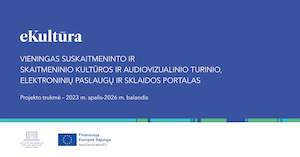A large and continuously updated collection of magnetic sound recordings is housed at the Lithuanian Folklore Archives (magnetic tapes and audiocasettes amounting to around 8,500 hours). The first sound recordings were made on magnetic tape in 1952 when fighters of the national resistance were still hiding in Lithuania’s forests, and were persecuted by the secret service of the Soviet Union. At that time, a new style of song was being sung in Lithuanian villages, created by the resistance fighters themselves as well as their supporters — village poets. These songs told of the fate of the resistance fighters, their battles and deaths. The notebooks in which these songs were recorded were hidden away because any contact with resistance fighters, uncovered clues, or any compromising materials, risked the threat of imprisonment or deportation. The folklore collectors were unable to record these songs as well, because if the Management of the Institute found out, they would be fired. However, in the later Soviet years some of the songs “slipped through” and wound up in the archive (some of the first recordings of these songs were made in 1978). Once the national independence movement started, the resistance songs were sung in public and documenting them became a priority. Thus, an especially large number of these songs were recorded in the 1990s. Drawing on the underground resistance press and the newly gathered material, a volume of resistance fighters’ songs was compiled and published:

From 2012–2014, together with other academic institutions, the Institute of Lithuanian Literature and Folklore executed the project supported by EU structural funds “Development and Providing Access to IRT Solutions and Content Helping to Preserve the Lithuanian Language in Public Space”. As part of this project, folklorists of the Institute began compiling the digital card catalogue of songs of the post-World War II armed resistance movement , as well as digitizing the magnetic tapes and cassettes on which these songs were recorded. In the Lithuanian Folklore Archives database, a collection of sound recordings of post-war resistance fighters’ songs was created (1,197 items). We invite you to listen to the archival recordings.
| Fondas: | LTR |
| Signature: | LTR 5834 |
| Song title : | Kęstučio Kuzmos dainų rinkinys |
| Inventorinimo data: | 1990. 12. |
| Fiziniai parametrai ir būklė: | Rankraštis gerai išsilaikęs, rašyta juodu, mėlynu rašikliu. Sąsiuvinio viršeliai pakietinti. Tekstas aiškiai įskaitomas. Rinkinys turi transkribuotų melodijų priedą. Rinkinio parametrai 16,5x20 cm. |
| Pastabos: |
Rinkinyje užrašytos pokario laikotarpio partizanų dainos.
Daugelis jų dainų turi išsamias ir įdomias pastabas. Pastaba prie dainos 47a: “Įrašė K. Aleksynas”. |
| Dokumentų rūšys: |
1. rankraščiai 2. natos |
| Apimtis (kiekis): | 1. puslapiai: 74 |
| Kalbos: | 1. lietuvių |
| Susiję ištekliai: |
1. LTRF mg 3787 (Pastabos: Kęstučio Kuzmos užrašytos tautosakos garso įrašas) |
| Anotacija: | Rinkinį sudaro 51 daina. |
| Bendras turinio vienetų kiekis: | 51 |
| Duomenų klasifikacija (žanrinis skirstymas): |
1. LIAUDIES DAINOS (1-47, 47a, 48-50) (Pastabos: Pastaba rinkinio įžangoje: “Dainos daugiausia išmoktos Panevėžio apylinkėje, dainuotos Joniškėlio žemės ūkio technikume...”) |
| Užrašymo metai: | 1989 |
| Užrašymo metų pastabos: | Rinkinyje nurodoma, kad dainos užrašytos ir įdainuotos į magnetofono juostą (LTRF mg 3787) 1989 metais, kovo mėnesį. |
| Užrašytojas: | Kęstutis Kuzma |
| Užrašymo vieta: |
Panevėžys m., , Panevėžio m. sav., Panevėžio apskr. (originale: ) |
| Pateikėjai: |
Kęstutis Kuzma , gyvenamoji vieta:
Panevėžys m., , Panevėžio m. sav., Panevėžio apskr. (pastabos: 1-14, 14a, 15-50; apsk.vnt: Pateikėjas gimė 1928 m.) |
| Kitų žmonių įnašai: | 1. Vita Ivanauskaitė - katalogino (Daina Nr. 7 sukataloginta 2001 03 13)2. Eligija Garšvienė - transkribavo melodiją (Šių dainų melodijos yra iššifruotos iš magnetinės juostos: Nr. 9, 13, 16, 18, 20, 34.) |
← Back to list





